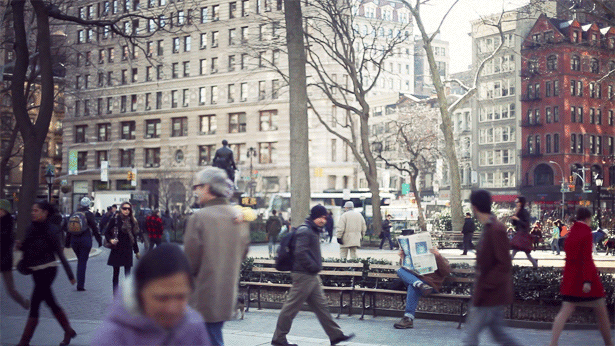 Here we can see an image that is designed around contrast. The creator utilizes contrast by placing two strips of photos, one with a darker backgroud and one with a lighter, against each other. This effect creates a surprising and eye catching juxtaposition through color contrast. As we learned in the lecture and readings it is important to use contrast in order for certain aspects of the design to pop. Here we can see that there is a pattern. First that the two images are creating a pinstripe and second that the lettering is in contrast with the images. Here the designer has chosen to confuse the mind. We can obviously see elements that make clear sense in our minds. i.e. the black to white stripes. However, once our minds attempt to place the two images into two separate images of a man the task becomes incredibly difficult. This is also apparent in the contrast of the text. Unlike the parallel strips the text does not sam to form any apparent pattern to the color. This element of juxtaposition leaves the receiver questioning and baffled, therefore the eye wanders and reaches the poster for clues.
Here we can see an image that is designed around contrast. The creator utilizes contrast by placing two strips of photos, one with a darker backgroud and one with a lighter, against each other. This effect creates a surprising and eye catching juxtaposition through color contrast. As we learned in the lecture and readings it is important to use contrast in order for certain aspects of the design to pop. Here we can see that there is a pattern. First that the two images are creating a pinstripe and second that the lettering is in contrast with the images. Here the designer has chosen to confuse the mind. We can obviously see elements that make clear sense in our minds. i.e. the black to white stripes. However, once our minds attempt to place the two images into two separate images of a man the task becomes incredibly difficult. This is also apparent in the contrast of the text. Unlike the parallel strips the text does not sam to form any apparent pattern to the color. This element of juxtaposition leaves the receiver questioning and baffled, therefore the eye wanders and reaches the poster for clues.FALURE
In the second image I chose we can obviously see some apparent problems with visuals and reading. The first and most obvious problem is the lack of contrast between the text and the background coloring. It is apparent that the creator of this font was looking to create a long, thin, and elegant font however the problem is that upon first glance you may not even notice that the font is there. If you would place the image into a grey scale you can quickly identify that the background is using a mid to dark grey tone for the positive space while using an almost white for the lettering. This does not show contrast but instead suggests that the font is created to seep into the background. Also another failure of this is that the designer chose a blue color for the "Light" element placed above the font. Here if we turn the image to greyscale we can quickly understand that the title dissipates into the mid grey of the background. This font may be elegant and unique, but the designer fails to illustrate the quality and possibilities of his font.



